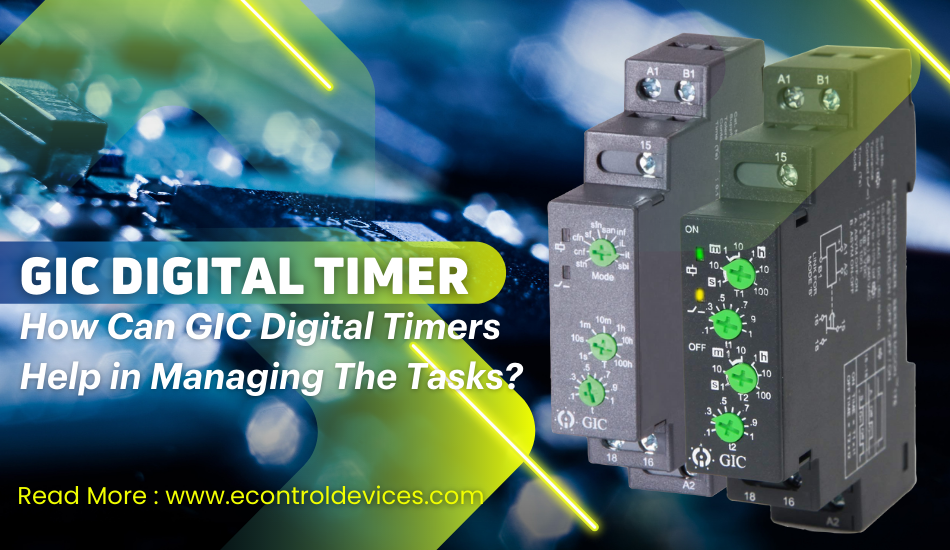Have you paid attention to the timer on your microwave? Have you noticed as you punch in the time duration, you get some digits flashed on a LED screen?
There is a timer working on counting the seconds and minutes. This is tracked through the GIC digital timers and clocks. The multifunction time delay relay or digital timers are also used in many industrial processes.
The timers have become an integral part of any process in several industries. The timers are also known as counters which measure the time at specific intervals. It is also used to monitor the time spent on a particular process. The timers or counters keep the record of time lapsed in the application process.
Types of Timers
There are various types of timers. Some even come embedded with the device, and some can be hooked up with the PLC, which will keep the record store for a long time. The main categories of timers are:
Analog Timers
This type can be set up through knobs. The analogue scale is used to record the output. The analogue type is easier to handle and can be adjusted by hand relatively quickly, and anyone can operate them.
Digital Timers
The digital timers work through the input, which is also digital and controlled and adjusted with the digital scale for output. There are some more functions, and all can be activated through the commands and buttons. For example, with GIC digital timer, you can select the set time and setpoints, and the display is done through the LED monitor.
The digital timers come in various types based on the application, from simple working principles to complex actions. The GIC digital timers are easy to use and portable and have an easy and integrative user interface.
There are several modes on which a timer can work, and these are:
Signal ON Delay Timer: This counts the delay set at specific intervals. As the name suggests, there is a delay before it counts the process.
Signal OFF Delay Timer: It is also known as a multifunction time delay relay, and it works precisely opposite the on-delay timer. The GIC digital timer starts as soon as the input starts, but the output is delayed, and the final output is given when the timer has expired.
The multifunction time delay relay is the control relay that has a slight delay built in. it counts the process after some time of current flow, and the circuits open and close before or after a slight delay.
You can automatically set the GIC digital timer’s value once it reaches its maximum counter value. The GIC digital timers come in various specifications, and you can select the most suitable one.
The multifunction time delay relay also has different specifications based on the requirement of the application. These are primarily used with the sync of the clock, which is embedded, and there is a specific range of cycles and baud rates that measures the time with delay.
Applications of Digital Timers
There is no limit for timers to be used, the digital timers are everywhere now, and they are used in applications ranging from consumer electronics to industrial processes. You can think of several processes that use some timers. Some of the applications can be:
- Restaurants and Bakeries
- Stadiums and Sports
- Self Checkout Counters
- Public Service Stations
- Production Line
Benefits
- The timers allow us to know the time spent on any activity.
- The conveyor belt or moving production line can speed up the process.
- These are a very cost-effective and feasible way to monitor the time in any process.
- It will help find the issues in the process as to which task is taking too much time.
- These also help to minimize the upkeep time.
- These are versatile and offer different services as timers.
Selection Process
There is a selection criterion for everything so does the digital timer.
Interface
The first thing to go for is the interface, and it should be user-friendly and easy to operate. Sometimes the timers need to reset quickly, and a complex interface will prevent the resetting.
Start/ Stop
The digital timers are based on the dry method in that it doesn’t need electricity to run and can be operated through dry contact.
Reset Time
The reset time should be quick as it shouldn’t take too much time between resetting.
Alarms
The alerts and alarms should be audible enough so the operator can hear the machine and reset the timer.
PLC Interface
The PLC interface needs to be compatible with the timer, and it can change the start up time.
Input Power
The most common and perfect working environment for industrial timers is 24VDC
Operating Environment
Industrial timers should be able to work in harsh manufacturing conditions.
Installation
The installation should also be easy and portable.
Conclusion
Digital timers are required in every process and everyday life. We all have timers as we sleep and bathe in a specific period, so we wear watched s and have clocks in our homes which show the time passed and time left.
Similarly, various industrial processes also want to count the number of times a task is done. It monitors the time-lapsed during the process and how much is still left to complete it. It gives way for better management of the tasks and processes. The GIC digital timer is one such timer that is very much in demand for industrial processes.

